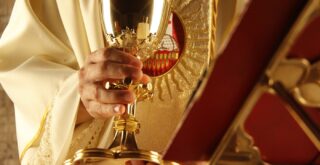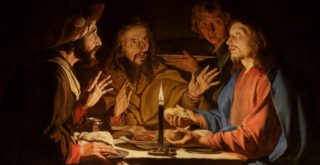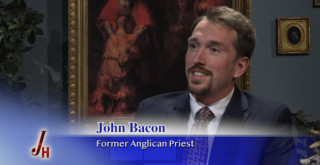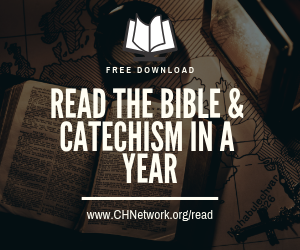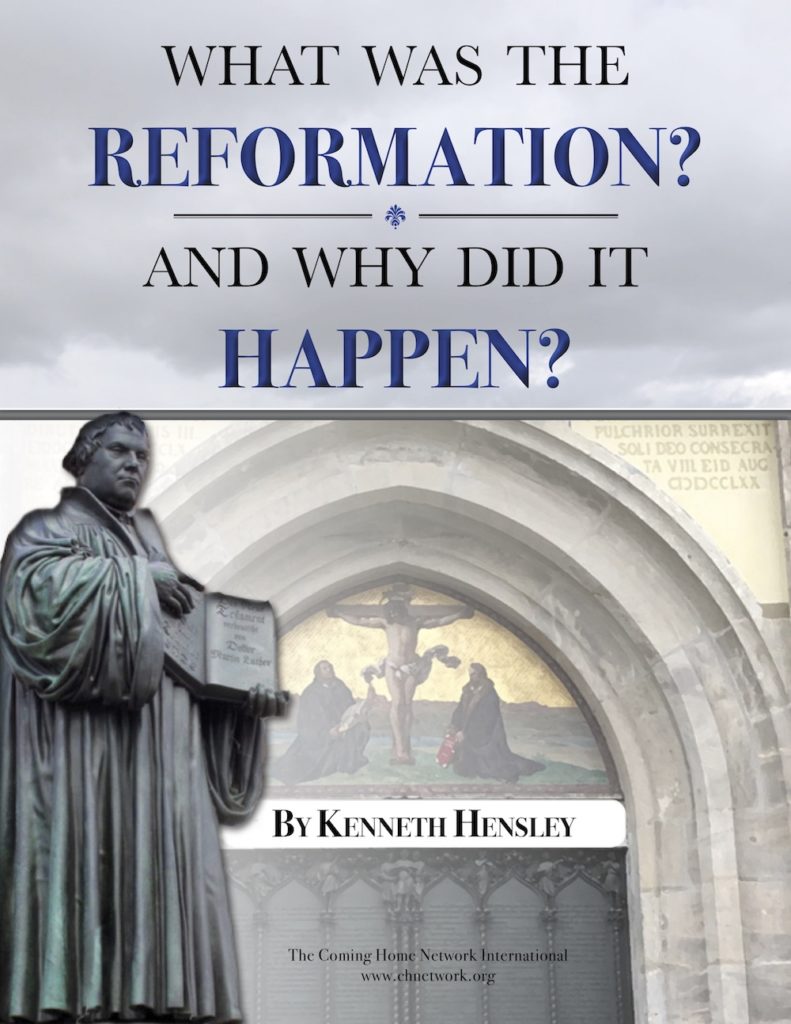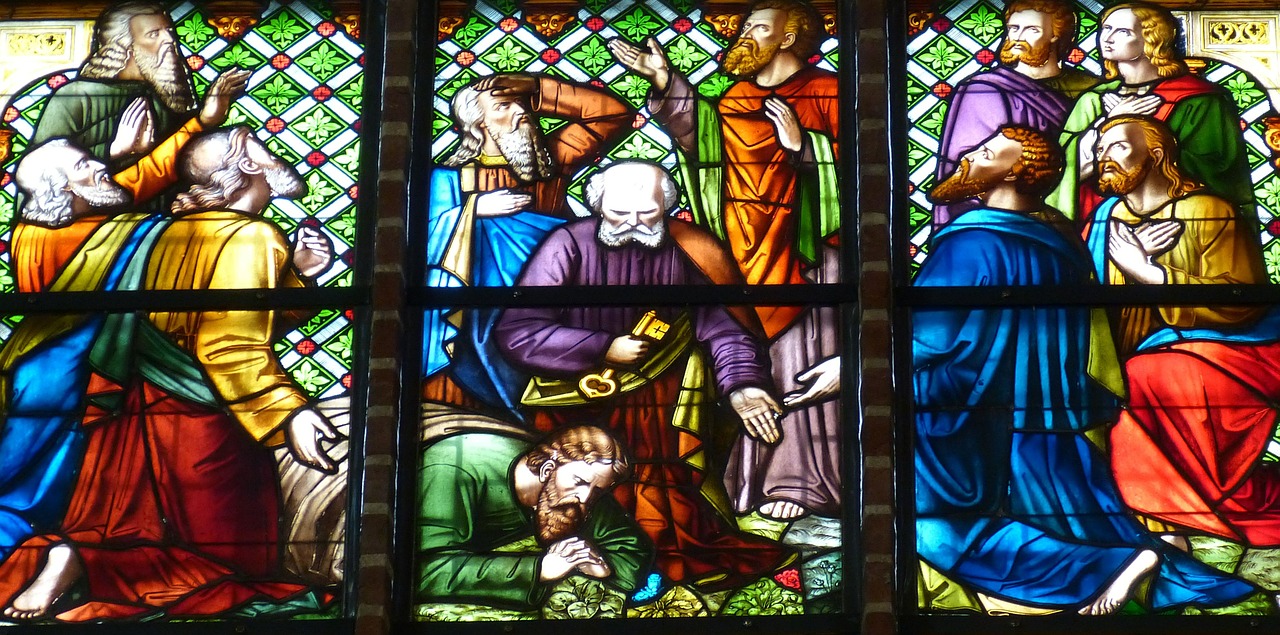
Both Catholics and most Protestants confess the same Apostles and Nicene creeds. The Apostles Creed (c. AD 360) states concerning the Church: “I believe in the Holy Spirit, the Holy Catholic Church, the communion of saints . . .” The Nicene Creed (AD 325 & 381) declares: “We believe in one holy catholic and apostolic Church.” Even though Protestants and Catholics confess the same creeds, their interpretation of these passages is dramatically different. Many Protestants would say that the Catholic Church is an invisible union of all believers in Jesus Christ throughout entire the world and through all time, in other words, the Kingdom of God. Many Protestants say, “I am catholic with a small ‘c’.” The Catholic understanding would be that though the Kingdom of God encompasses all believers, the Catholic Church is the faithful body of believers on earth in communion with the apostolic authority established by Jesus Christ in union with the successor of Peter the chief of the apostles.
How are we in the 21st century to know the original and true meaning of the term “Catholic Church?” The best way is to discover how the teachers of the early Church used the word during the time in which the ancient creeds were written. In that way we will be able to better understand whether to interpret the creeds as meaning the “invisible Church of all believers” or “the divinely established and authoritative institutional Church established by Christ through his apostles.”
Let’s look at some of these examples:
St. Ignatius of Antioch, Letter to the Smyrneans 8:2, AD 107.
Let no one do anything of concern to the Church without the bishop. Let that be considered a valid Eucharist, which is celebrated by the bishop or by one whom he ordains [i.e., a presbyter]. Wherever the bishop appears, let the people be there, just as wherever Jesus Christ is, there is the Catholic Church.
St. Polycarp, The Martyrdom of Polycarp, 8:1, & 16:2, AD 156.
When at last he had finished his prayer, in which he remembered all who had met with him ant any time, both small and great, both those with and those without renown, and the whole Catholic Church throughout the world. . .
And certainly the most admirable Polycarp was one of these [elect], in whose times among us he showed himself an apostolic and prophetic teacher and bishop of the Catholic Church in Smyrna.
Tertullian, Demurrer Against the Heretics, 20, AD 200.
Where was [the heretic] Marcian, that shipmaster of Pontus, the zealous student of Stoicism? Where was Valentinus, the disciple of Platonism? For it is evident that those men lived not so long ago – in the reign of Antoninus [AD 138-161] for the most part – and that they at first were believers in the doctrine of the Catholic Church, in the church of Rome under the episcopate of the blessed Eleutherus [AD 175-189], until on account of their ever restless curiosity, with which they even infected the brethren, they were more than once expelled. . . . Afterward . . . Marcian professed repentance and agreed to the conditions granted to him – that he should receive reconciliation if he restored to the Church all the others whom he had been training for perdition; he was prevented, however, by death.
Clement of Alexandria, Stromaties 7:17:107:3, aft. AD 202.
From what has been said, then, it seems clear to me that the true Church, that which is really ancient, is one; and in it are enrolled those who, in accord with a design, are just. . . . We say, therefore, that in substance, in concept, in origin and in eminence, the ancient and Catholic Church is alone, gathering as it does into the unity of the one faith which results from the familiar covenants, – or rather, from the one covenant in different times, by the will of the one God and through the one Lord, – those already chosen, those predestined by God who knew before the foundation of the world that they would be just.
St. Cyprian of Carthage, Letter of Cyprian to All His People 43 (40), 5, AD 251.
They who have not peace themselves now offer peace to others. They who have withdrawn from the Church promise to lead back and to recall the lapsed to the Church. There is one God and one Christ, and one Church, and one Chair founded on Peter by the word of the Lord. It is not possible to set up another altar or for there to be another priesthood besides that one altar and that one priesthood. Whoever has gathered elsewhere is scattering.
St. Cyril of Jerusalem, Catechetical Lectures 18:23, AD 350.
[The Church] is called Catholic, then, because it extends over the whole world, from end to end of the earth, and because it teaches universally and infallibly each and every doctrine which must come to the knowledge of men, concerning things visible and invisible, heavenly and earthly, and because it brings every race of men into subjection to godliness . . .
St. Augustine, The True Religion 7:12, AD 390.
We must hold to the Christian religion and to communication in her Church, which is Catholic and which is called Catholic not only by her own members but even by all her enemies. When heretics or the adherents of schisms talk about her, not among themselves but with strangers, willy-nilly they call her nothing else but Catholic. They will not be understood unless they distinguish her by this name, which the whole world employs in her regard.
St. Augustine, Against the Letter of Mani Called ‘The Foundation’ 5:6, AD 397.
If you should find someone who does not yet believe in the gospel what would you [Mani] answer him when he says, “I do not believe”? Indeed, I would not believe the gospel myself if the authority of the Catholic Church did not move me to do so.
Vincent of Lerins, Notebooks 3:5, AD 434.
What then will a Catholic Christian do if a small portion of the Church has cut itself off from the communion of the universal faith? What, surely, but prefer the soundness of the whole body to the unsoundness of a pestilent and corrupt member?
A careful reading of these witnesses from early Christian history shows us that the Church affirmed by the Fathers, articulated in the Creeds, and adhered to by those who called themselves Christians from the earliest days of Christianity, was indeed the one, holy, catholic and apostolic Church. These early Christian testimonies give us a picture of a visible Church, with apostolic authority, unity in belief and mission, and with Christ as its foundation and head. They show us that the Church was, from its very beginnings, understood as a visible reality, and Catholic both in the small ‘c’ and large ‘C’ senses of the word.

